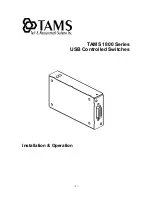
Chapter 24 Multicast
XGS-4728F User’s Guide
208
24.6.2 MVR Modes
You can set your Switch to operate in either dynamic or compatible mode.
In dynamic mode, the Switch sends IGMP leave and join reports to the other
multicast devices (such as multicast routers or servers) in the multicast VLAN.
This allows the multicast devices to update the multicast forwarding table to
forward or not forward multicast traffic to the receiver ports.
In compatible mode, the Switch does not send any IGMP reports. In this case, you
must manually configure the forwarding settings on the multicast devices in the
multicast VLAN.
24.6.3 How MVR Works
The following figure shows a multicast television example where a subscriber
device (such as a computer) in VLAN 1 receives multicast traffic from the
streaming media server, S, via the Switch. Multiple subscriber devices can connect
through a port configured as the receiver on the Switch.
When the subscriber selects a television channel, computer A sends an IGMP
report to the Switch to join the appropriate multicast group. If the IGMP report
matches one of the configured MVR multicast group addresses on the Switch, an
entry is created in the forwarding table on the Switch. This maps the subscriber
VLAN to the list of forwarding destinations for the specified multicast traffic.
When the subscriber changes the channel or turns off the computer, an IGMP
leave message is sent to the Switch to leave the multicast group. The Switch
sends a query to VLAN 1 on the receiver port (in this case, an uplink port on the
Switch). If there is another subscriber device connected to this port in the same
subscriber VLAN, the receiving port will still be on the list of forwarding destination
for the multicast traffic. Otherwise, the Switch removes the receiver port from the
forwarding table.
Figure 107
MVR Multicast Television Example
Summary of Contents for XGS-4728F
Page 2: ......
Page 8: ...Safety Warnings XGS 4728F User s Guide 8 ...
Page 24: ...24 ...
Page 30: ...Chapter 1 Getting to Know Your Switch XGS 4728F User s Guide 30 ...
Page 34: ...Chapter 2 Hardware Installation and Connection XGS 4728F User s Guide 34 ...
Page 42: ...Chapter 3 Hardware Overview XGS 4728F User s Guide 42 ...
Page 44: ...44 ...
Page 78: ...Chapter 7 System Status and Port Statistics XGS 4728F User s Guide 78 ...
Page 92: ...Chapter 8 Basic Setting XGS 4728F User s Guide 92 ...
Page 94: ...94 ...
Page 114: ...Chapter 9 VLAN XGS 4728F User s Guide 114 ...
Page 118: ...Chapter 10 Static MAC Forward Setup XGS 4728F User s Guide 118 ...
Page 148: ...Chapter 14 Bandwidth Control XGS 4728F User s Guide 148 ...
Page 162: ...Chapter 17 Link Aggregation XGS 4728F User s Guide 162 ...
Page 186: ...Chapter 21 Policy Rule XGS 4728F User s Guide 186 ...
Page 230: ...Chapter 25 AAA XGS 4728F User s Guide 230 ...
Page 268: ...268 ...
Page 324: ...324 ...
Page 332: ...Chapter 38 Maintenance XGS 4728F User s Guide 332 ...
Page 358: ...Chapter 41 Syslog XGS 4728F User s Guide 358 ...
Page 366: ...Chapter 42 Cluster Management XGS 4728F User s Guide 366 ...
Page 370: ...Chapter 43 MAC Table XGS 4728F User s Guide 370 ...
Page 374: ...Chapter 44 IP Table XGS 4728F User s Guide 374 ...
Page 378: ...Chapter 46 Routing Table XGS 4728F User s Guide 378 ...
Page 382: ...382 ...
Page 392: ...Chapter 48 Troubleshooting XGS 4728F User s Guide 392 ...
Page 402: ...Chapter 49 Product Specifications XGS 4728F User s Guide 402 ...
Page 404: ...404 ...
Page 408: ...Appendix A Legal Information XGS 4728F User s Guide 408 ...
















































